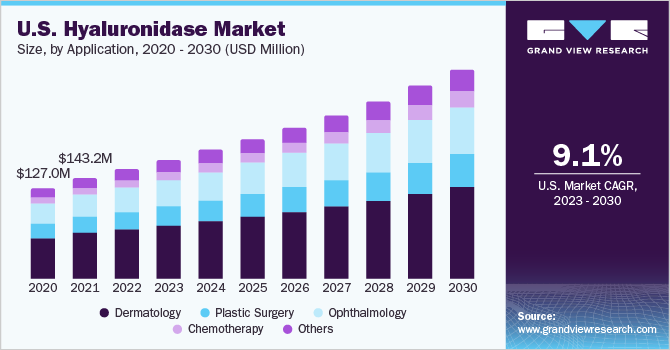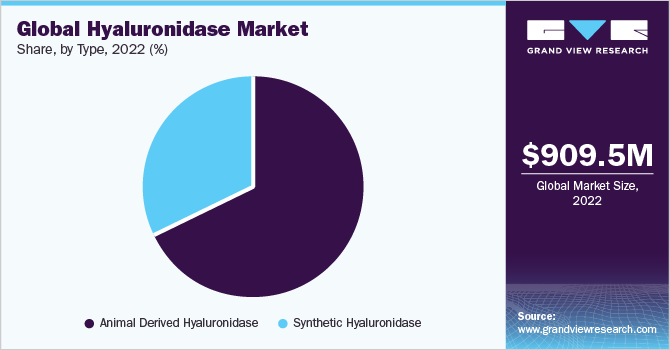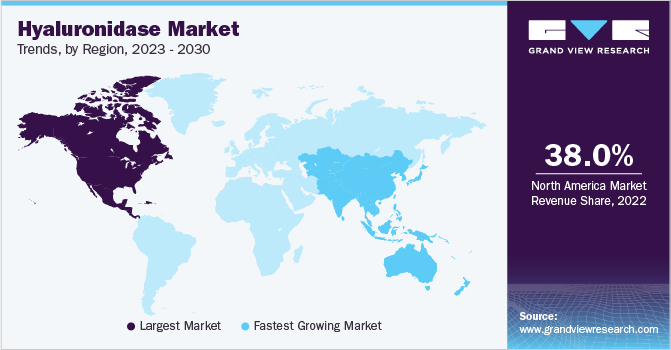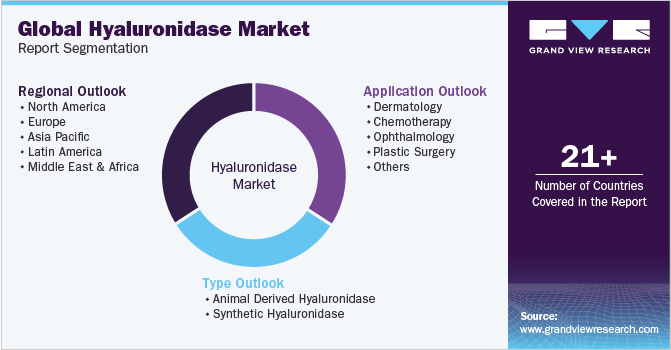- Home
- »
- Medical Devices
- »
-
Hyaluronidase Market Size & Share Analysis Report, 2030GVR Report cover
![Hyaluronidase Market Size, Share & Trends Report]()
Hyaluronidase Market Size, Share & Trends Analysis Report By Type (Animal Derived, Synthetic), By Application (Dermatology, Chemotherapy), By Region, And Segment Forecasts, 2023 - 2030
- Report ID: GVR-4-68038-132-0
- Number of Report Pages: 130
- Format: PDF, Horizon Databook
- Historical Range: 2018 - 2021
- Forecast Period: 2023 - 2030
- Industry: Healthcare
Report Overview
The global hyaluronidase market size was estimated at USD 909.5 million in 2022 and is anticipated to grow at a compound annual growth rate (CAGR) of 8.4% from 2023 to 2030. The rising penetration across various application areas and the presence of several clinical studies to demonstrate the efficacy of the products are expected to fuel the market growth. Hyaluronidase finds applications in cosmetic treatments, cancer therapy, and ophthalmic therapeutic solutions. Its emerging role in cancer metastasis and therapy owing to the use of enzyme-based substrates for noninvasive tumor imaging is anticipated to drive the demand and consequent market growth with lucrative avenues.

Moreover, rising awareness regarding the alteration of physical appearance has led to an increasing demand for cosmetics and aesthetic procedures. The demand for hyaluronidase across cosmetic dermatology is increasing and is primarily driven by a rise in the prevalence of skin disorders and easy access to advanced cosmetic treatments in various regions. Other factors responsible for the projected growth include an increasing geriatric population, favorable reimbursement policies, and a rising number of people opting for aesthetic nonsurgical procedures.
Hyaluronidase therapy can correct fillers injected in excessive quantities and also aid in dissolving subcutaneous nodules. This has increased the interest of professionals operating in the cosmetic industry to gain knowledge regarding usage, application methods, and adverse effects of this enzyme.
The abovementioned factors have increased the adoption of enzymes in the management of hyaluronic acid fillers. However, rare symptoms of hyaluronidase injection administered subcutaneously include rapid heartbeats, skin rashes, unusual weakness, and dizziness among others, whereas symptoms of overdose include blurred vision, sweating, and confusion among others.
Thus, the practitioner/beautician must be well versed with the appropriate dosage of hyaluronidase along with their possible complications & required remedies. Rising advancements targeted towards reducing the side effects related to hyaluronidase administration are expected to offer lucrative opportunities to the key players operating in this market.
Application Insights
In terms of application, the dermatology segment held the largest revenue share of approximately 44.6% in 2022. The increasing significance of hyaluronidase use in dermatology has resulted in the highest revenue generation. The establishment of a standard protocol is expected to improve the momentum of market growth in the near future.
The chemotherapy segment is estimated to register the fastest CAGR of 10.5% over the forecast period. Several research and case studies have suggested its use to resolve extravasation. Utility as an adjunct in chemotherapy is associated with increased tumor response to chemotherapeutic drugs, as observed in clinical trials and experimental animal models subjected to this enzyme.
Hyaluronidase enzyme depolymerizes hyaluronic acid and enables enhanced permeability of connective tissues. Such properties have led to numerous applications in recent years. The use of hyaluronidase has increased, especially in medicine, to augment the absorption and dispersion of other injected drugs. Thus, hyaluronidase is finding positive feedback and increased use in chemotherapy & osteoarthritis and is contributing to the growth of market revenue.
Type Insights
In terms of type, the animal-derived hyaluronidase segment held the largest revenue share of 67.0% in 2022. It is expected to maintain its dominance throughout the forecast period, as most approved and commercialized brands are currently derived from animal sources. However, limitations associated with animal-derived products have prompted the development and use of synthetic products. Several studies have shown the high efficacy of recombinant human hyaluronidase in enhancing the quality and safety of local anesthetic blocks.

Moreover, the recombinant product is also proven to be highly consistent and pure, which has increased its preference among professionals. The preference is further supplemented by useful insights rendered in comparative analyses between animal-derived and synthetically derived products. The synthetic hyaluronidase segment is anticipated to register the fastest CAGR of 9.4% over the forecast period.
Regional Insights
In terms of region, North America dominated the market in 2022 with the largest revenue share of 38.0% due to the presence of major players manufacturing these products, high adoption of advanced treatment options, and a substantial number of dermatology clinics prescribing such treatments. A rise in the number of experimental procedures that provide an in-vitro evaluation of the biological availability of hyaluronidase is expected to increase the penetration of products in different regions globally.

Asia Pacific is anticipated to grow at the fastest CAGR of 9.3% during the forecast period as a consequence of medical tourism for dermatology treatments and chemotherapy applications in various countries of the region. In addition, the presence of a substantial number of suppliers coupled with the advent of technology in South Korea is further expected to propel the market growth. In July 2018, Alteogen developed the world’s second recombinant human hyaluronidase protein and patented the protein engineering technology.
Key Companies & Market Share Insights
The market is highly competitive, and the players are undertaking strategies such as mergers & acquisitions, product launches, and collaborations to increase their market penetration. In January 2023, Alteogen Inc. announced an exclusive license arrangement with Sandoz AG. In accordance with the terms of the contract, Sandoz obtained the right to use ALT-B4, a unique hyaluronidase derived using Hybrozyme technology, to commercialize Sandoz’s biosimilar product subcutaneous version.
In June 2021, SoftFil Cosmetics launched Topilase, a topical care product, which is a natural alternative to injectable hyaluronidase. In February 2019, Genetech, Inc., a subsidiary of Roche Holding AG, received FDA approval for its product Herceptin Hylecta, which is a subcutaneous injection designed for the treatment of patients suffering from breast cancer. The recommended dose for Herceptin Hylecta is 600 mg/10,000 units. This is a combination of 10,000 units of hyaluronidase and 600 mg trastuzumab, wherein the former helps deliver the latter beneath the skin. Some prominent players in the global hyaluronidase market include:
-
Amphastar Pharmaceuticals, Inc.
-
PrimaPharma, Inc.,
-
Halozyme, Inc.
-
Bausch & Lomb Incorporated
-
The Cooper Companies Inc.,
-
Sun Pharmaceutical Industries Ltd.
-
STEMCELL Technologies Inc.
-
Shreya Life Sciences Pvt. Ltd.
Hyaluronidase Market Report Scope
Report Attribute
Details
Market size value in 2023
USD 986.9 million
Revenue forecast in 2030
USD 1,734.6 million
Growth rate
CAGR of 8.4% from 2023 to 2030
Base year for estimation
2022
Historical data
2018 - 2021
Forecast period
2023 - 2030
Report updated
September 2023
Quantitative units
Revenue in USD million and CAGR from 2023 to 2030
Report coverage
Revenue forecast, company ranking, competitive landscape, growth factors, and trends
Segments covered
Type, application, region
Regional scope
North America; Europe; Asia Pacific; Latin America; MEA
Country scope
U.S.; Canada; UK; Germany; France; Italy; Spain; Denmark; Sweden; Norway; China; Japan; India; Australia; South Korea; Thailand; Brazil; Mexico; Argentina; Saudi Arabia; South Africa; UAE; Kuwait
Key companies profiled
Amphastar Pharmaceuticals, Inc.; PrimaPharma, Inc.; Halozyme, Inc.; Bausch & Lomb Incorporated; The Cooper Companies Inc.; Sun Pharmaceutical Industries Ltd.; STEMCELL Technologies Inc.; Shreya Life Sciences Pvt. Ltd.
Customization scope
Free report customization (equivalent up to 8 analyst’s working days) with purchase. Addition or alteration to country, regional & segment scope
Pricing and purchase options
Avail customized purchase options to meet your exact research needs. Explore purchase options
Global Hyaluronidase Market Report Segmentation
This report forecasts revenue growth at global, regional, and country levels and provides an analysis of the latest industry trends in each of the sub-segments from 2018 to 2030. For this study, Grand View Research has segmented the global hyaluronidase market report on the basis of type, application, and region:

-
Type Outlook (Revenue, USD Million, 2018 - 2030)
-
Animal-derived Hyaluronidase
-
Synthetic Hyaluronidase
-
-
Application Outlook (Revenue, USD Million, 2018 - 2030)
-
Dermatology
-
Chemotherapy
-
Ophthalmology
-
Plastic Surgery
-
Others
-
-
Regional Outlook (Revenue, USD Million, 2018 - 2030)
-
North America
-
U.S.
-
Canada
-
-
Europe
-
Germany
-
UK
-
France
-
Italy
-
Spain
-
Sweden
-
Norway
-
Denmark
-
-
Asia Pacific
-
China
-
Japan
-
India
-
Australia
-
Thailand
-
South Korea
-
-
Latin America
-
Brazil
-
Mexico
-
Argentina
-
-
Middle East & Africa
-
Saudi Arabia
-
South Africa
-
UAE
-
Kuwait
-
-
Frequently Asked Questions About This Report
b. The global hyaluronidase market size was estimated at USD 909.5 million in 2022 and is expected to reach USD 986.9 million in 2023.
b. The global hyaluronidase market is expected to witness a compound annual growth rate of 8.4% from 2023 to 2030 to reach USD 1,734.6 million by 2030.
b. Animal-derived products captured the largest market share of 66.9% in 2022. This is attributed to the fact that the majority of the approved and commercialized brands are currently derived from animal sources.
b. Key players in the market include Amphastar Pharmaceuticals, Inc., PrimaPharma, Inc., Halozyme, Inc., Bausch & Lomb Incorporated, The Cooper Companies Inc., Sun Pharmaceutical Industries Ltd., STEMCELL Technologies Inc., and Shreya Life Sciences Pvt. Ltd.
b. Key factors that are driving the market growth include increase in the prevalence of skin disorders, easy access to advanced cosmetic treatments, and favorable reimbursement policies.
Share this report with your colleague or friend.
![gvr icn]()
NEED A CUSTOM REPORT?
We can customize every report - free of charge - including purchasing stand-alone sections or country-level reports, as well as offer affordable discounts for start-ups & universities. Contact us now
![Certified Icon]()
We are GDPR and CCPA compliant! Your transaction & personal information is safe and secure. For more details, please read our privacy policy.
We are committed towards customer satisfaction, and quality service.
"The quality of research they have done for us has been excellent."





